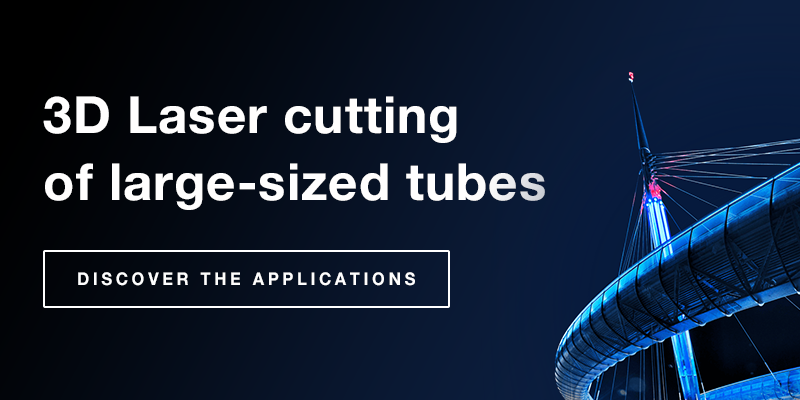The steel construction sector demands radical changes in the processes used to cut H, C and IPE type tubes and profiles and to prepare them for successive fabrication steps. There is an increased demand to construct ultra-modern structures. The ever-increasing complexity of forms and requirement of esthetically appealing appearances present a growing fabrication challenge. This modern trend is also seen in residential buildings. Additional aspects of the modern trend are eco-sustainability and the need to complete the projects in shorter time frames to reduce costs.
These developments are driving these sectors towards an increasing use of steel and complex joineries between various structural components like tubes and profiles. Steel structures enable advantages in form, design flexibility and function today and into future due to their sturdiness and appealing appearance.
The increased use of steel requires the preparation of precisely manufactured individual components off-site for quick and cost-effective assembly on-site.
Key advantages of off-site steel part and assembly manufacturing and preparation:
1. Reduced on-site time and workload
Nowadays there is a persistent and ever-increasing pressure to complete infrastructure projects (public and private) as fast and accurately as possible to reduce time to market use and increase profitability.
More often than not, the need to have a skilled workforce on-site (interpret drawings, cut, chamfer and grind parts etc.) becomes the bottleneck in completing projects on time and on budget.
Even for a skilled work-force, the traditional method is to have a 1:1 drawing on paper, place it on the part to be cut, mark the part, cut the shape with a gas or plasma torch and grind the edges followed by holes for rivets or bolts being manually drilled. This process offers low precision and hence a greater percentage of rework, adjustments and full part scrapping during the final assembly stage resulting in heavy losses in terms of time and money.
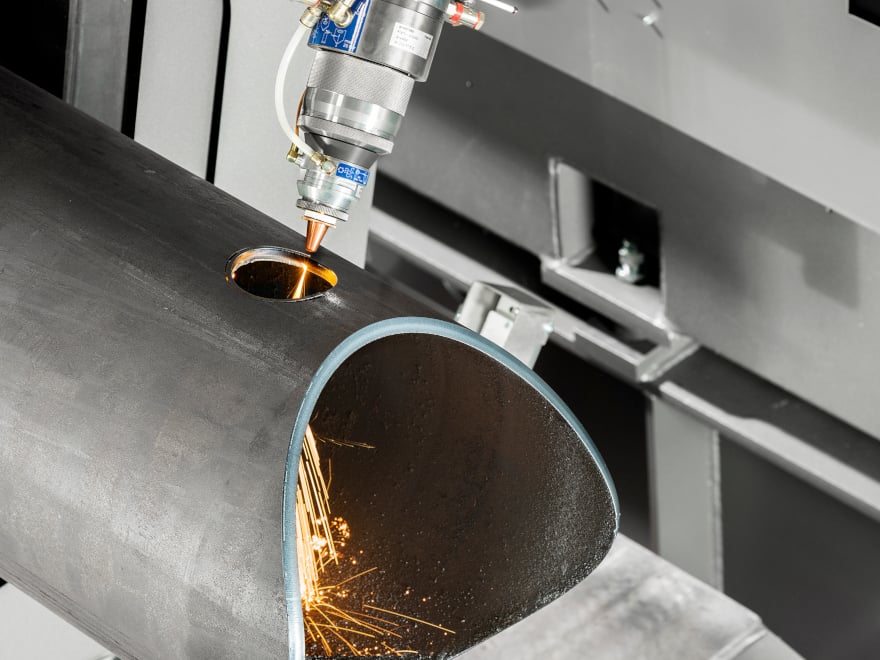 LT14 appropriately cutting tube for subsequent on-site welding.
LT14 appropriately cutting tube for subsequent on-site welding.
Today’s modern technology allows all these operations (drawing transfer, cutting, edge management, hole placement) to be completed using a single machine. The 3D Lasertube cutting machines cuts large size tubes and profiles with a high cut edge quality and dimensional accuracy resulting in parts that are ready for direct assembly / welding without any additional processing. The payoff is increased time and cost savings.
The 3D Lasertube allows manufacturers to provide ready-made parts to the construction site for assembly and/or welding and considerably reduce installation times and on-site labor requirements.
Discover the advantages of large size Lasertube machines suitable for cutting tubes and profiles
2. Reduction of project time-lines and relative cost savings
The various elements used in steel structures (profiles including IPE, HEA, HEB, C, tubes etc.) are very expensive. Hence it is important to shorten the project time-line as much as possible to reduce overall cost.
From this viewpoint, any improvement at every stage of the project like programming, handling, processing, assembly etc. is beneficial to shorten the project time-line and hence reduce costs and improve profit margins.
3. Productivity and Efficiency
Laser cutting technology has revolutionized the manufacturing process for many users manufacturing sector and has improved their efficiency and productivity.
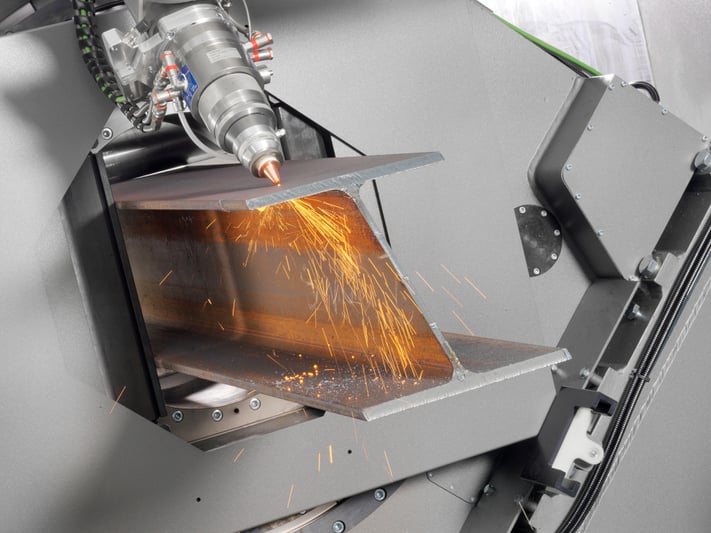 Laser cutting of an HEA profile on LT24 Lasertube system.
Laser cutting of an HEA profile on LT24 Lasertube system.
Compared to the commonly used plasma cutting technology, laser cutting technology is faster, cleaner and more efficient. Laser cut edges are burr-free and hence subsequent deburring is not required. Additionally, the heat affected zone generated during laser cutting is much smaller compared to plasma cutting and therefore improves the strength of the joint.
The other commonly used method is multi-axis machining centers. Laser cutting does not require any tools and thus no tool changes or adjustments. For this reason laser cutting offers higher flexibility and also the capability to carry out certain operations that would have required dedicated special tooling with the conventional machining method.
4. Process automation
With an increasing trend of fabricating individual parts for assembly not on-site but in an off-site location, the volume of material movement has increased and therefore the need to rely on efficient handling systems for loading and unloading parts on the machine. This requirement has become even more important as parts made from tubes are increasingly heavy.
The handling system must also be capable of automatically handling parts with different shapes and dimensions – round, square or rectangular, various profiles like C, HEA, HEB, IPE, flats etc. The system therefore must be flexible, versatile and automatic; it should not require any manual adjustments or utilize dedicated shape dependent clamps that the operator has to change from time to time.
The incorporation of handling systems in the manufacturing process is a significant advantage because they reduce human labor and eliminates tooling while adding tremendous flexibility is part shape, dimensions and weight while directly increasing operational speed, accuracy and efficiencies.
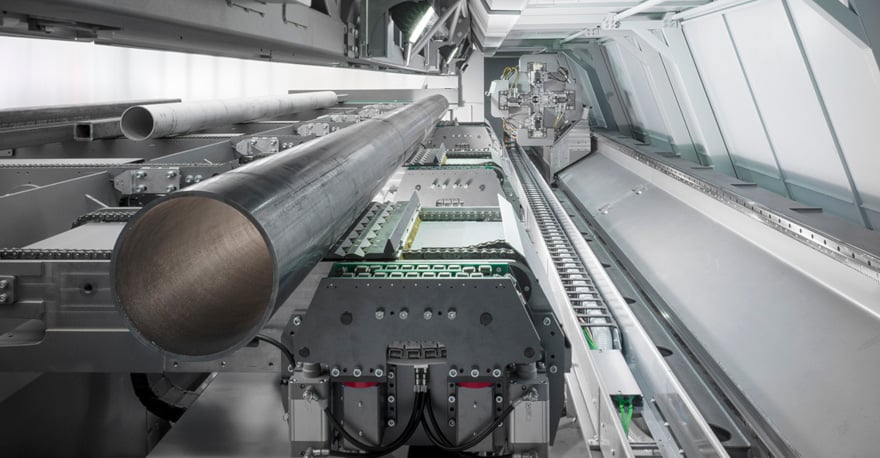 Loading of tubes with different cross sections on Lasertube LT14 FIBER.
Loading of tubes with different cross sections on Lasertube LT14 FIBER.
Lasertube for large diameter tubes and profiles are equipped with modern loading systems specially developed for them. They can automatically load a large variety of raw material, different in shape and dimensions, without any profile specific devices or manual adjustments.
The raw tubes or sections are loaded on the chain loader. They do not require alignment or positioning in a specific manner. The machine automatically handles them and loads them on to the cutting line.
5. Easy creation of innovative designs
The complexity of the joinery between tubes and profiles is increasing as more commercial and public structures (airports, bridges, stations etc) have started relying on steel in their construction and design. As a result, a single element may require the cutting of multiple complex shapes on to it.
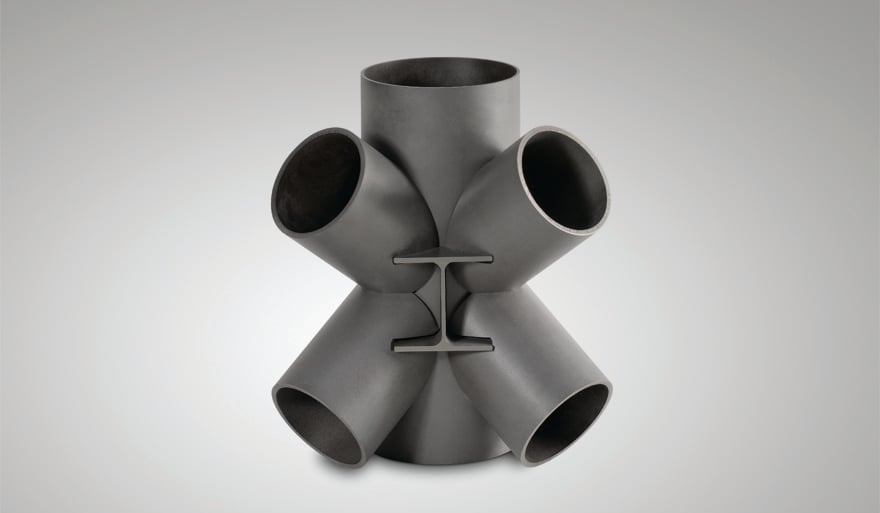 An example of innovative node design incorporating tubes and HEA profile. These parts were cut on an LT24 system used for laser cutting of large dimension tubes and profiles.
An example of innovative node design incorporating tubes and HEA profile. These parts were cut on an LT24 system used for laser cutting of large dimension tubes and profiles.
The traditional programming method used in the steel structure sector are predefined Macros that are parametric entities; changing the dimensions of a given geometry but not changing its shape. This is a big limitation.
For each new shape, a new Macro must be purchased. This requirement directly increases cost and production delays.
To overcome the limitations of custom Macros, a flexible and powerful CAD/CAM software should be used to allow the user to develop and modify, at will, the project by incorporating innovative designs and stronger joineries that fully exploit the potentials of the laser cutting technologies.
The requirements mentioned above are fulfilled by Artube. At present, it is the most advanced CAD/CAM software available for designing structures and single parts and then automatically creating machine programs to cut the parts made of large diameter tubes or profiles. It can also import drawing files in different formats including STEP, IGES and IFC made using different software programs. Artube is capable not only of importing and processing files in these formats but it also allows the user to modify single parts, as required, in an intuitive and simple way.
Artube is part of the BLMelements software suite which also includes Protube.
Protube is the production management software that allows integration with the company ERP system from an Industry 4.0 perspective to provide complete traceability of each part.


